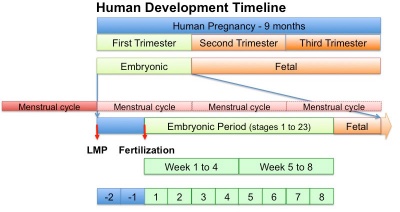Gestational Age
| Embryology - 20 Apr 2024 |
|---|
| Google Translate - select your language from the list shown below (this will open a new external page) |
|
العربية | català | 中文 | 中國傳統的 | français | Deutsche | עִברִית | हिंदी | bahasa Indonesia | italiano | 日本語 | 한국어 | မြန်မာ | Pilipino | Polskie | português | ਪੰਜਾਬੀ ਦੇ | Română | русский | Español | Swahili | Svensk | ไทย | Türkçe | اردو | ייִדיש | Tiếng Việt These external translations are automated and may not be accurate. (More? About Translations) |
Gestational Age (GA), or menstrual age, is a clinical term usually given in weeks and days to describe human development timed from the first day of the last menstrual period (LMP).
For gestational age in assisted reproductive technology pregnancy 2 weeks are added to the fertilisation date.
This clinical age therefore differs by approximately two weeks from the research materials timed from fertilization (fertilization age or conceptional age). These second terms are generally not used clinically.
Note - This current website preferentially uses the approximate fertilization age, except for some clinical presentations, and may also list the GA.
- A template link from the GA acronym brings readers to this current page, use your browser back button to return to the original page.
- Links: Timeline human development | Menstrual Cycle | Week 1 | Assisted Reproductive Technology | Birth
| Gestational Age (weeks) | 1 | 2 | 3 | 4 | 5 | 6 | 7 | 8 | 9 | 10 |
| Fertilisation Age (weeks) | 1 | 2 | 3 | 4 | 5 | 6 | 7 | 8 |
Term Pregnancy
Definition of term pregnancy - American College of Obstetricians and Gynecologists Committee (2013 Opinion no 579)[1] "In the past, the period from 3 weeks before until 2 weeks after the estimated date of delivery was considered "term," with the expectation that neonatal outcomes from deliveries in this interval were uniform and good. Increasingly, however, research has shown that neonatal outcomes, especially respiratory morbidity, vary depending on the timing of delivery within this 5-week gestational age range."
Recommended that "term" be replaced with the more specific terminology related to gestational age:
- early term - 37 0/7 weeks of gestation through 38 6/7 weeks of gestation.
- full term - 39 0/7 weeks of gestation through 40 6/7 weeks of gestation.
- late term - 41 0/7 weeks of gestation through 41 6/7 weeks of gestation.
- postterm - 42 0/7 weeks of gestation and beyond.
- Links: Birth
Estimating Due Date (EDD)
- Known LMP and normal 28 day cycle.
- Calculate EDD by adding 280 days.
- Cycle Variations
- cycle greater than 28 days add 1 day for each day above 28
- cycle less than 28 days subtract 1 day for each day below 28
- Ultrasound can alter EDD calculation.
Method for estimating due date - Committee on Obstetric Practice American Institute of Ultrasound in Medicine Society for Maternal-Fetal Medicine (2014 Committee opinion no 611)[2] "Accurate dating of pregnancy is important to improve outcomes and is a research and public health imperative. As soon as data from the last menstrual period, the first accurate ultrasound examination, or both are obtained, the gestational age and the estimated due date should be determined, discussed with the patient, and documented clearly in the medical record. Subsequent changes to the estimated due date should be reserved for rare circumstances, discussed with the patient, and documented clearly in the medical record. When determined from the methods outlined in this document for estimating the due date, gestational age at delivery represents the best obstetric estimate for the purpose of clinical care and should be recorded on the birth certificate. For the purposes of research and surveillance, the best obstetric estimate, rather than estimates based on the last menstrual period alone, should be used as the measure for gestational age. Comment in American College of Obstetricians and Gynecologists releases committee opinion on estimation of due date. [J Midwifery Womens Health. 2015]"
Perinatal Period
American Academy of Pediatrics Committee on Fetus and Newborn 2004 recommendations[3]
- Gestational age (completed weeks) - time elapsed between the first day of the last menstrual period and the day of delivery. If pregnancy was achieved using assisted reproductive technology, gestational age is calculated by adding 2 weeks to the conceptional age.
- Chronological age (days, weeks, months, or years) - time elapsed from birth.
- Postmenstrual age (weeks) - gestational age plus chronological age.
- Corrected age (weeks or months) - chronological age reduced by the number of weeks born before 40 weeks of gestation; the term should be used only for children up to 3 years of age who were born preterm.
Crown Rump Length
| Gestational Age and Crown-Rump Length (measured by ultrasound) | ||||||||||||||||||||||||||||||||||||||||||||||||||||||||||||||||||||||||||||||||||||||||||||||||||||||||||||||||||||||||||||||||||||||||
|---|---|---|---|---|---|---|---|---|---|---|---|---|---|---|---|---|---|---|---|---|---|---|---|---|---|---|---|---|---|---|---|---|---|---|---|---|---|---|---|---|---|---|---|---|---|---|---|---|---|---|---|---|---|---|---|---|---|---|---|---|---|---|---|---|---|---|---|---|---|---|---|---|---|---|---|---|---|---|---|---|---|---|---|---|---|---|---|---|---|---|---|---|---|---|---|---|---|---|---|---|---|---|---|---|---|---|---|---|---|---|---|---|---|---|---|---|---|---|---|---|---|---|---|---|---|---|---|---|---|---|---|---|---|---|---|---|
| ||||||||||||||||||||||||||||||||||||||||||||||||||||||||||||||||||||||||||||||||||||||||||||||||||||||||||||||||||||||||||||||||||||||||
References
- ↑ <pubmed>24150030</pubmed>
- ↑ <pubmed>25244460</pubmed>
- ↑ <pubmed>15520122</pubmed>| Pediatrics.
Glossary Links
- Glossary: A | B | C | D | E | F | G | H | I | J | K | L | M | N | O | P | Q | R | S | T | U | V | W | X | Y | Z | Numbers | Symbols | Term Link
Cite this page: Hill, M.A. (2024, April 20) Embryology Gestational Age. Retrieved from https://embryology.med.unsw.edu.au/embryology/index.php/Gestational_Age
- © Dr Mark Hill 2024, UNSW Embryology ISBN: 978 0 7334 2609 4 - UNSW CRICOS Provider Code No. 00098G
